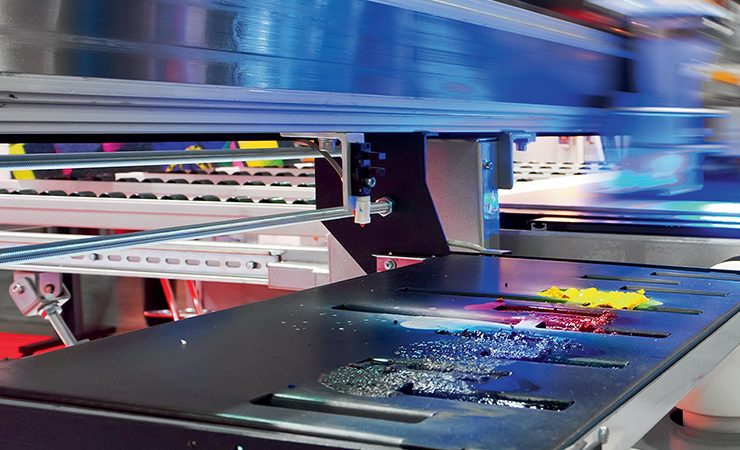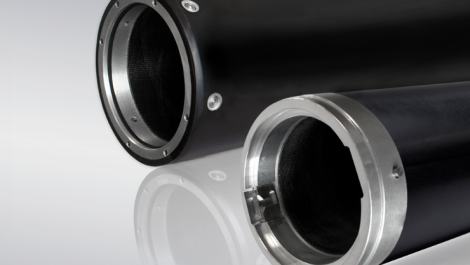In a market where customers are increasingly more concerned about appearing sustainable, UV-LED inks have an advantage over their conventionally cured relatives. However, some printers are still reluctant to take advantage of this technology.
For the UK label industry, UV-LED technology suddenly became a hot topic in the third quarter of 2021. Driven by concerns about rapidly rising energy prices, label converters – whether large multinationals or single-facility companies – are aggressively seeking ways of improving operating efficiencies and reducing power consumption. UVLED inks are being given serious consideration thanks to their strong cost and sustainability advantages.
The world of LED cascaded into the UV flexo market by way of OEMs and UV systems suppliers with the belief that ink and coating manufactures had an immediate offering, and so began supporting customers through the transition from arc to LED lamp technology.
Amanda Jones, Paragon Inks’ business development & marketing director, said, ‘Journeying back in time reveals that luck more than judgment allowed for the first ranges of LED ink and coatings to be created, by appropriating existing UV raw material technologies. Time, the creative mechanism, then allowed the downstream supply chain of pre-curser and raw material suppliers to begin to align themselves with the fast-moving pace of equipment and ultimately customer needs.
‘Moving forward into the current day, this time-space continuum between the customer, equipment suppliers and the downstream supply chain is starting to decrease year-on-year, and from an ink and coating manufacturers point of view. We are now seeing the amount of suitable raw materials for the LED palette increase and more excitingly new bespoke technology developments materialising, proving that the alignment is getting stronger allowing for Food Packaging Complaint solutions, such as Paragon Inks’ AURA LED range, or compostable choices, such as Paragon Inks’ GAIA LED range.’
UV-LED systems become more cost-competitive which drives continuous growth and further transition from traditional UV systems. With increased productivity, lower costs and higher safety, the utilisation of UV-LED offers relevant benefits for the industry value chain and are considered a sustainable alternative to traditional UV systems.
Myths and legends
There are myths that are often repeated about LED curing and switching, and this misinformation is making it unnecessarily difficult for converters to make clear ROI projections.
‘At Flint Group, we have seen a big rise in queries about switching from conventional UV curing to LED curing,’ said Keith Redmond, regional manager, UK & Ireland, Flint Group Narrow Web. ‘Making the switch to LED curing can save companies significant amounts of money with very little risk. Each converter needs to carefully assess the perceived obstacles that are preventing the move. Also, apart from any obstacles, there are some myths surrounding the switch to LED curing.’
There are two primary obstacles: risk and cost. Those who fear being one of the first to switch to LED curing should have a look at the experience in North America where it is fast becoming the norm. On the matter of cost, the benefits have been widely published and range from the longevity of LED lamps, their low running cost, to the absence of generated heat that needs to be extracted.
Mr Redmond debunked some of the myths surrounding these inks. He said, ‘Market availability; Not all colours and varnishes are available in the LED ranges. A look at Flint Group’s portfolio quickly demonstrates that this is not true.
‘Performance; a second myth is that they do not perform as well as standard flexo inks. Again, this can be dispelled by conversations with ink and substrate suppliers who can show you samples so you can judge for yourself. LED inks do require slight adjustments in housekeeping, for example, greater care is needed in leaving ink cans and trays exposed to daylight. But this is simple best practice that your ink supplier can help you with.
‘The third myth is related to cost. The actual costs of the investment have come down. A converter with, say, three presses might be worried about having to stock and run two ink types, and is under the misapprehension that it’s a lot more expensive to retrofit or buy a new press with LED. This is no longer true. New LED systems are easily retrofittable and switchable – and when you add Flint Dual Cure inks that are also compatible with mercury lamps to the equation, the numbers drop significantly.’
Coming under Flint’s EkoCure brand, Dual Cure LED-hybrid inks are formulated at the same strength as their conventional counterparts, making colour-matching simple. This means existing Flint customers can adopt the technology without the need for colour re-matching.
EkoCure F is suited for printing on almost all film and paper labelstocks, as well as cartons and tags. EkoCure ANCORA Dual Cure meets the most stringent FCM food safety and material exclusion requirements. EkoCure XS is specifically for shrink sleeve labels, and can shrink by up to 70% without deterioration of the printed image.
Furthermore, Flint’s complete Dual Cure portfolio is supported by VIVO Colour Solutions, the company’s ink recipe software and support service for reproducing spot colours with repeatable precision.
Long term planning
Siegwerk is continually working on the development of future-oriented UV-LED inks and coatings. Today, the company’s portfolio contains UV and UV-LED inks and coatings for several applications including food, hygiene and pharma packaging.
With Sicura Nutriflex LEDTec, Siegwerk offers a low migration UVLED flexo ink series for food and pharma packaging. Furthermore, a variety of complementary products rounds off Siegwerk’s broad UV portfolio, adding gloss and matte coatings for different applications like TTR, hot-foil stamping, direct thermal printing or high slip applications, special release coatings, cold foil adhesives or gold and silver metallic inks.
According to the company, its products offer optimal curing results, safe fulfillment of legal requirements, and no sensory impact. They show a high degree of strength and resistance for different packaged products and are suitable for printing at high production speeds. Most of the company’s developments involve dual cure systems, technologies that cure with either UV mercury or UV-LED technology.
The focus will not only be on highly reactive systems that can be printed and cured at the highest possible speed and with optimal process reliability but can also contribute to improving the recycling quality of packaging in the sense of a circular economy.
In this context, higher printing efficiency already goes hand in hand with ecology and sustainability, as resources are already conserved through faster printing and less waste.
In addition, the company is working on various projects in the context of a circular economy, for example to be able to recycle shrink sleeves more efficiently and with higher quality or to further optimise the deinking properties of its own inks.
Danish ink supplier Resino feels that the uptake of UV-LED inks has been greater in some areas than in others, with flexible packaging really dragging behind. Resino’s vice president commercial director Niels Nielsen said, ‘We have already seen a massive change from mercury UV lamps to UV-LED curing lamps in inkjet, offset and flexo for labels. We have not yet seen a major switch for printing on flexible packaging. But with recent developments in lamp technology and inks, a similar change is likely to happen also for flexible packaging.
Resino has developed the UV-LED ink range RESUCAT, which has been designed with a raw material selection to maintain the food safety and migration characteristics as obtained with other RESUCAT 210 ink series.
The RESUCAT ink range contains products also suitable for flexible packaging, including shrink sleeves, shrink bags, retort and wet sterilisation resistant print.
Solar power
Sun Chemical says that its UV-LED inks serve as examples of the company’s sustainability commitments.
Its SolarWave FSP ink range is a migration-compliant UV-LED flexo ink which has also passed plant toxicity tests and is in the process of receiving a certification for composability. The range for UV-LED flexo packaging is available as finished inks or as part of the dispersion system through a dedicated UV-LED technology varnish. The inks demonstrate all the capabilities of conventional UV flexo inks when cured under suitable UV-LED curing systems.
Sun Chemical also has a number of products that are suitable for UV-LED and standard Mercury UV lamps. The company’s SolarFlex inks for UV flexo are suitable for printing on a variety of substrates on paper, board and film and sensitive applications. They offer outstanding dot reproduction and work with high press speeds, particularly for the label and narrow web market.
Sun Chemical’s Rayoflex Electron White is a fully compliant UV flexo ‘first-down’ opaque white ink intended for the printing of labels, flexible packaging and sleeves for printers who require a low migration solution.
The ink has excellent adhesion to a wide range of filmic substrates with high opacity and printability providing a scratch and scuff resistant finish, making it particularly suited to food and pharmaceutical packaging applications.
This feature was first published in the December 2021 issue of FlexoTech, which you can read online here; register here to receive the magazine, for free






